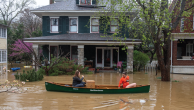In the days after Hurricane Katrina devastated the Gulf Coast region and knocked out cell phone towers and landline telephone service, citizens, local community organizations, government agencies and news outlets turned to the internet as a communication lifeline during the crisis.
The Pew Internet Project director, Lee Rainie, shared his thoughts on the internet’s role in facilitating disaster relief in a recent Baltimore Sun article:
“I think people have a sense that the Internet is a tremendously powerful and useful tool for them to provide human aid and comfort. You can do it from anywhere on the planet where there’s a modem. You don’t have to be living in the vicinity in order to make a difference or show your concern.”
Full story: “On the Internet, offers of assistance”
We’ve gathered a small sampling of relief sites that strike us as interesting applications of the internet’s impact. If you’d like to share additional examples with us, you can contact us here.
•Family News Network of the International Committee of the Red Cross – This site provides a large database for those seeking information about relatives who may have been affected by the hurricane.
•CNN Help Center – This page offers a long list of links that include information where victims can find help, those seeking missing loved ones, those wanting to donate and volunteer, share their stories, and learn more about the status of the affected areas.
•Craigslist – The craigslist.org housing section was one of the first sites that people flocked to in order to offer free housing to displaced victims of the hurricane, and the site promptly created a general resource section for the affected and those wishing to volunteer. Other anticipated uses of the site include those who orchestrated meetup points to distribute aid in person.
•Katrina Help Wiki – This collaborative, open source website was designed to serve as a centralized repository of all aid information related to the hurricane relief efforts. Individuals contribute their time to enter data and other information that will help streamline the information collected for relief purposes, with a particular focus on finding missing persons and reuniting those who have been separated. The PeopleFinder database located at katrinalist.net is just one of the valuable resources that emerged through this shared effort.
•Katrina Aftermath Blog – On August 30th, Andy Carvin of the Digital Divide Network started the “Katrina Aftermath” blog, a site that serves as a clearinghouse for Katrina-related writing, photographs, video and podcasts. Users can email and phone-in their contributions, and many of them have used a system of Flikr photo tags to share their images with the world.
•Scipionus – This interactive map was created for the use of people affected by Hurricane Katrina to provide information about the status of specific locations affected by the storm. However, many people have also used the site to inquire about missing persons in certain areas or convey messages that they are safe.




